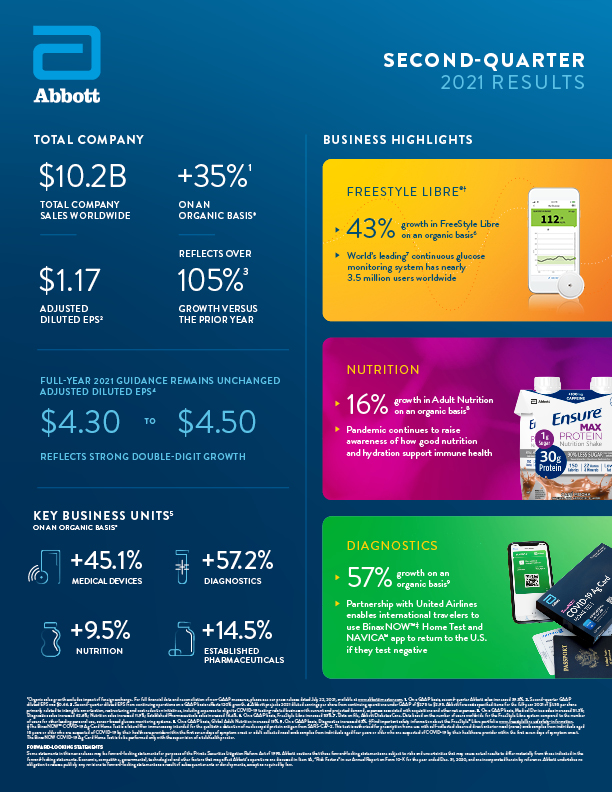Important Safety Information
FREESTYLE LIBRE 2 INDICATIONS AND IMPORTANT SAFETY INFORMATION
The FreeStyle Libre 2 Flash Glucose Monitoring System is a continuous glucose monitoring (CGM) device with real time alarms capability indicated for the management of diabetes in persons age 4 and older.*
WARNINGS/LIMITATIONS*:
The System must not be used with automated insulin dosing (AID) systems, including closed loop and insulin suspend systems. Remove the sensor before MRI, CT scan, X-ray, or diathermy treatment. Do not take high doses of vitamin C (more than 500 mg per day), as this may falsely raise your Sensor readings. Failure to use the System according to the instructions for use may result in missing a severe low blood glucose or high blood glucose event and/or making a treatment decision that may result in injury. If glucose alarms and readings from the System do not match symptoms or expectations, use a fingerstick blood glucose value to make diabetes treatment decisions. Seek medical attention when appropriate and contact Abbott Toll Free (855-632-8658) or visit * www.freestylelibre.us for detailed indications for use and safety information.
*Please refer to www.freestylelibre.us for the indications and important safety information.
XIENCE
XIENCE Skypoint™, XIENCE Sierra™, XIENCE Alpine™ (XIENCE™ Family) Everolimus Eluting Coronary Stent Systems
Indications:
The XIENCE Skypoint™, XIENCE Sierra™ and XIENCE Alpine™ Stent Systems are indicated for improving coronary artery luminal diameter in patients, including those at high risk for bleeding and those with diabetes mellitus, with symptomatic heart disease due to de novo native coronary artery lesions (length ≤ 32 mm) with reference vessel diameters of ≥ 2.25 mm to ≤ 4.25 mm.. In addition, the XIENCE Skypoint™, XIENCE Sierra™ and XIENCE Alpine™ Stent Systems are indicated for treating de novo chronic total coronary occlusions.
Contraindications: The XIENCE Skypoint™, XIENCE Sierra™ and XIENCE Alpine™ Stent Systems are contraindicated for use in:
· Patients who cannot tolerate, including allergy or hypersensitivity to, procedural anticoagulation or the post-procedural antiplatelet regimen.
· Patients with hypersensitivity or contraindication to everolimus or structurally-related compounds, or known hypersensitivity to stent components (cobalt, chromium, nickel, tungsten, methacrylic polymer, fluoropolymer), or with contrast hypersensitivity.
Warnings:
· Each stent and the delivery system are for single use only. Do not reuse, reprocess, or resterilize. Note the product “Use by” date on the package. Reuse, reprocessing, or resterilization may compromise the structural integrity of the device and / or delivery system and / or lead to device failure, which may result in patient injury, illness, or death. Reuse, reprocessing, or resterilization may also create a risk of contamination of the device and / or cause patient infection or cross-infection, including, but not limited to, the transmission of infectious disease(s) from one patient to another. Contamination of the device and / or delivery system may lead to injury, illness, or death of the patient.
· It is not recommended to treat patients having a lesion that prevents complete inflation of an angioplasty balloon.
· Antiplatelet therapy should be administered post-procedure.
· This product should not be used in patients who are not likely to comply with the recommended antiplatelet therapy.
· Judicious selection of patients is necessary, since the use of this device carries the associated risk of stent thrombosis, vascular complications, and/or bleeding events.
· The XIENCE Skypoint™, XIENCE Sierra™ and XIENCE Alpine™ Stent Systems are coated with an everolimus and polymer coating at the full implant stent length. The distal and intermediate portions of the device, the tip, and tapers of the balloon are coated with HYDROCOAT™ Hydrophilic Coating.
Failure to abide by the warnings in this labeling might result in damage to the device coating, which may necessitate intervention or result in serious adverse events.
Precautions:
· Implantation of the stent should be performed only by the physicians who have received appropriate training.
· Stent placement should be performed at centers where emergency coronary artery bypass graft surgery (CABG) can be readily performed.
· To confirm sterility has been maintained, ensure that the inner package sterile barrier has not been opened or damaged prior to use.
· Subsequent restenosis may require repeat dilatation of the arterial segment containing the stent. The long-term outcome following repeat dilatation of the stent is unknown at present.
· Care should be taken to control the guiding catheter tip during stent delivery, deployment, and balloon withdrawal. Before withdrawing the stent delivery system, visually confirm complete balloon deflation by fluoroscopy to avoid guiding catheter movement into the vessel and subsequent arterial damage.
· When the XIENCE Skypoint™, XIENCE Sierra™ and XIENCE Alpine™ Stent Systems are used outside the specified Indications for Use, patient outcomes may differ from the results observed in the SPIRIT family of clinical trials.
Compared to use within the specified indications for use, the use of the XIENCE Skypoint™, XIENCE Sierra™ and XIENCE Alpine™ Stent Systems in patients and lesions outside of the labeled indications, including more tortuous anatomy, may have an increased risk of adverse events, including stent thrombosis, stent embolization, MI, or death.
· The extent of the patient’s exposure to drug and polymer is directly related to the number of stents implanted. See Instructions for Use for current data on multiple stent implantation.
· Safety and effectiveness of the XIENCE Skypoint™, XIENCE Sierra™ and XIENCE Alpine™ Stent Systems have not been established for subject populations with the following clinical settings:
o Patients with prior brachytherapy of the target lesion or the use of brachytherapy for treated site restenosis.
o Conjunctive use of the XIENCE Skypoint™, XIENCE Sierra™ and XIENCE Alpine™ Stent Systems with either mechanical atherectomy devices or laser angioplasty catheters.
o Women who are pregnant or lactating, men intending to father children, pediatric.
o Unresolved vessel thrombus at the lesion site, coronary artery reference vessel diameters < 2.25 mm or > 4.25 mm or lesion lengths > 32 mm, lesions located in saphenous vein grafts, lesions located in unprotected left main coronary artery, ostial lesions, or lesions located at a bifurcation or previously stented lesions, diffuse disease or poor flow (TIMI < 1) distal to the identified lesions, excessive tortuosity proximal to or within the lesion, recent Acute Myocardial Infarction (AMI) or evidence of thrombus in target vessel, multivessel disease, and in-stent restenosis.
· Formal drug interaction studies have not been performed with the XIENCE Skypoint™, XIENCE Sierra™ or XIENCE Alpine™ Stent Systems because of limited exposure to everolimus eluted from XIENCE Skypoint™, XIENCE Sierra™ and XIENCE Alpine™ Stent Systems.
o Everolimus, the active ingredient in the stents, is an immunosuppressive agent. Consideration should be given to patients taking other immunosuppressive agents or who are at risk for immune suppression.
o Oral everolimus use in renal transplant and advanced renal cell carcinoma patients was associated with increased serum cholesterol and triglyceride levels, which in some cases required treatment.
o Nonclinical testing has demonstrated that the XIENCE Skypoint™, XIENCE Sierra™ and XIENCE Alpine™ Stent Systems in single and in overlapped configurations up to 71 mm in length, are MR Conditional. See Instructions for Use for detailed scanning conditions
Potential Adverse Events: Adverse events that may be associated with PCI treatment procedures and the use of a stent in native coronary arteries include, but are not limited to, the following:
· Allergic reaction or hypersensitivity to latex, contrast agent anesthesia, device materials, and drug reactions to everolimus, anticoagulation, or antiplatelet drugs
· Vascular access complications which may require transfusion or vessel repair, including: Catheter site reactions, Bleeding, Arteriovenous fistula; pseudoaneurysm, aneurysm, dissection, perforation/rupture, Embolism, Peripheral nerve injury, Peripheral ischemia
· Coronary artery complications which may require additional intervention, including: Total occlusion or abrupt closure, Arteriovenous fistula, pseudoaneurysm, aneurysm, dissection. Perforation/rupture, Tissue prolapse/plaque shift, Embolism, Coronary or stent thrombosis, Stenosis or restenosis
· Pericardial complications which may require additional intervention, including: Cardiac tamponade, Pericardial effusion, Pericarditis.
· Cardiac arrhythmias
· Cardiac ischemic conditions (including myocardial ischemia, myocardial infarction (including acute), coronary artery spasm, and unstable or stable angina pectoris)
· Stroke/Cerebrovascular Accident (CVA) and Transient Ischemic Attack (TIA)
· System organ failures: Cardio-respiratory arrest, Cardiac failure, Cardiopulmonary failure, Renal Insufficiency/failure, Shock
· Bleeding
· Blood cell disorders
· Hypotension and/or hypertension
· Infection
· Nausea and vomiting
· Palpitations
· Dizziness
· Syncope
· Chest Pain
· Fever
· Pain
· Death
The risks described below include the anticipated adverse events relevant for the cardiac population referenced in the contraindications, warnings and precaution sections of the everolimus labels / SmPCs and / or observed at incidences ≥ 10% in clinical trials with oral everolimus for different indications. Please refer to the drug SmPCs and labels for more detailed information and less frequent adverse events.
· Abdominal pain
· Anemia
· Angioedema
· Arterial Thrombotic Events
· Bleeding and coagulopathy
· Constipation
· Cough
· Diabetes mellitus
· Diarrhea
· Dyspnea
· Embryo-fetal toxicity
· Erythema
· Erythroderma
· Headache
· Hepatic artery thrombosis
· Hepatic disorders
· Hypersensitivity to everolimus active substance, or to other rapamycin derivates
· Hypertension
· Infections (bacterial, fungal, viral or protozoan infections, including infections with opportunistic pathogens). Polyoma virus-associated nephropathy (PVAN), JC virus-associated progressive multiple leukoencephalopathy (PML), fatal infections and sepsis have been reported in patients treated with oral everolimus
· Kidney arterial and venous thrombosis
· Laboratory test alterations
· Lymphoma and skin cancer
· Male infertility
· Menstrual irregularities
· Nausea
· Nephrotoxicity
· Non-infectious pneumonitis
· Oral ulcerations
· Pain
· Pancreatitis
· Pericardial effusion
· Peripheral edema
· Pleural effusion
· Pneumonia
· Pyrexia
· Rash
· Renal Failure
· Upper respiratory tract infection
· Urinary tract infection
· Venous thromboembolism
· Vomiting
· Wound healing complications
Live vaccines should be avoided and close contact with those that have had live vaccines should be avoided. Fetal harm can occur when administered to a pregnant woman. There may be other potential adverse events that are unforeseen at this time.

